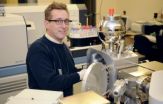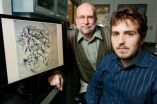New discoveries make it harder for HIV to hide from drugs
How the virus can escape even the best cocktail of treatments described in Nature journal
2010-12-16
(Press-News.org) The virus that causes AIDS is chameleon-like in its replication. As HIV copies itself in humans, it constantly mutates into forms that can evade even the best cocktail of current therapies. Understanding exactly how HIV cells change as they reproduce is key to developing better tests and treatments for patients.
In the Journal of Biological Chemistry and Nature Structural & Molecular Biology, MU microbiologist and biochemist Stefan Sarafianos, PhD, reveals new findings that shed light on how HIV eludes treatment by mutating. His discoveries provide clues into HIV's mechanisms for resisting two main families of drugs.
"These findings are important because identifying a new mutation that affects HIV drug resistance allows physicians to make better decisions and prescribe the proper drugs," Sarafianos said. "Without that knowledge, therapy can be suboptimal and lead to early failure."
Patients with HIV are routinely tested to track the levels of the virus and immune cells in their body. Results of the tests help physicians gauge the health of their patients and prescribe the right mix of antiviral drugs. The drugs help prevent the spread of HIV in patients by inhibiting the virus' ability to replicate.
Sarafianos' lab determined the biochemical properties that allow strains of HIV with a specific mutation — the N348I mutation — to escape inhibition despite treatment with Nevirapine. The drug is commonly used in combination with other antiviral medications to decrease the amount of HIV in the blood. As a result of Sarafianos' discovery, at least one major company that manufactures HIV mutation-testing kits has modified its test to detect the N348I mutation.
Sarafianos' recent findings resulted from research supported by five National Institutes of Health grants. He recently received another $417,000 award from the NIH to assist him in developing modified antibodies for HIV therapy.
"Our latest efforts to design broadly neutralizing antibodies against HIV will hopefully expand our toolbox against the virus, which remains a constantly moving target," Sarafianos said.
###
END
ELSE PRESS RELEASES FROM THIS DATE:
2010-12-16
For the first time in history, a change will be made to the atomic weights of some elements listed on the Periodic table of the chemical elements posted on walls of chemistry classrooms and on the inside covers of chemistry textbooks worldwide.
The new table, outlined in a report released this month, will express atomic weights of 10 elements - hydrogen, lithium, boron, carbon, nitrogen, oxygen, silicon, sulfur, chlorine and thallium - in a new manner that will reflect more accurately how these elements are found in nature.
"For more than a century and a half, many ...
2010-12-16
CHAMPAIGN, Ill. — University of Illinois researchers have found a key to keeping stem cells in their neutral state: It takes a soft touch.
In a paper published in the journal PLoS One, the researchers demonstrated that culturing mouse embryonic stem cells (mESCs) on a soft gel rather than on a hard plate or dish keeps them in their pluripotent state, a ground state with the ability to become any type of tissue. The soft substrate maintains homogeneous pluripotent colonies over long periods of time – without the need for expensive growth chemicals.
"This has huge applications ...
2010-12-16
Red tides and similar blooms can render some seafood unsafe to eat, though it can be difficult to tell whether a particular batch harbors toxins that cause food poisoning.
A new kind of marker developed by chemists at the University of California, San Diego, and reported in the journal ChemComm makes it easier to see if shellfish are filled with toxin-producing organisms.
Mussels and oysters accumulate single-celled marine creatures called dinoflagellates in their digestive systems as they filter seawater for food. Usually dinoflagellates are harmless, but sometimes ...
2010-12-16
CHAMPAIGN, Ill. — Fortified with iron: It's not just for breakfast cereal anymore. University of Illinois researchers have demonstrated a simpler method of adding iron to tiny carbon spheres to create catalytic materials that have the potential to remove contaminants from gas or liquid.
Civil and environmental engineering professor Mark Rood, graduate student John Atkinson and their team described their technique in the journal Carbon.
Carbon structures can be a support base for catalysts, such as iron and other metals. Iron is a readily available, low-cost catalyst ...
2010-12-16
Using an automated screening technique developed by pharmaceutical companies to find new drugs, a team of researchers from UC San Diego and three other research institutions has discovered a molecule with the most potent effects ever seen on the biological clock.
Dubbed by the scientists "longdaysin," for its ability to dramatically slow down the biological clock, the new compound and the application of their screening method to the discovery of other clock-shifting chemicals could pave the way for a host of new drugs to treat severe sleep disorders or quickly reset the ...
2010-12-16
Los Angeles, CA (December 15, 2010) Being a part of many different social groups can improve mental health and help a person cope with stressful events. It also leads to better physical health, making you more able to withstand—and recover faster from—physical challenges, according to a study in the current Social Psychological and Personality Science (published by SAGE).
Belonging to groups, such as networks of friends, family, clubs and sport teams, improves mental health because groups provide support, help you to feel good about yourself and keep you active. But ...
2010-12-16
Los Angeles, CA (December 15, 2010) When computerized neuropsychological testing is used, high school athletes suffering from a sports-related concussion are less likely to be returned to play within one week of their injury, according to a study in The American Journal of Sports Medicine (published by SAGE). Unfortunately, concussed football players are less likely to have computerized neuropsychological testing than those participating in other sports.
A total of 544 concussions were recorded by the High School Reporting Information Online surveillance system during ...
2010-12-16
ANCHORAGE, Alaska – Sea-ice habitats essential to polar bears would likely respond positively should more curbs be placed on global greenhouse gas emissions, according to a new modeling study published today in the journal, Nature.
The study, led by the U.S. Geological Survey, included university and other federal agency scientists. The research broke new ground in the "tipping point" debate in the scientific community by providing evidence that during this century there does not seem to be a tipping point at which sea-ice loss would become irreversible.
The report ...
2010-12-16
Washington, D.C.—Scientists from all over the world are taking a second, more expansive, look at the car-sized asteroid that exploded over Sudan's Nubian Desert in 2008. Initial research was focused on classifying the meteorite fragments that were collected two to five months after they were strewn across the desert and tracked by NASA's Near Earth Object astronomical network. Now in a series of 20 papers for a special double issue of the journal Meteoritics and Planetary Science, published on December 15, researchers have expanded their work to demonstrate the diversity ...
2010-12-16
A small area deep in the brain called the perirhinal cortex is critical for forming unconscious conceptual memories, researchers at the UC Davis Center for Mind and Brain have found.
The perirhinal cortex was thought to be involved, like the neighboring hippocampus, in "declarative" or conscious memories, but the new results show that the picture is more complex, said lead author Wei-chun Wang, a graduate student at UC Davis.
The results were published Dec. 9 in the journal Neuron.
We're all familiar with memories that rise from the unconscious mind. Imagine looking ...
LAST 30 PRESS RELEASES:
[Press-News.org] New discoveries make it harder for HIV to hide from drugs
How the virus can escape even the best cocktail of treatments described in Nature journal


